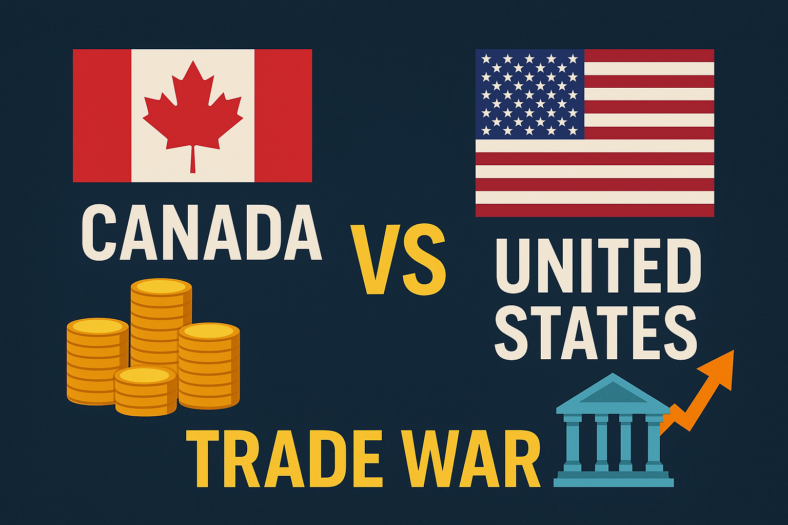From the bustling streets of Toronto to the serene shores of Vancouver, Canadians seek convenience, reliability, and value in their banking relationships. A chequing account serves as the cornerstone of these relationships, facilitating everyday transactions, bill payments, and financial management with ease. Yet, with varying fee structures, perks, and accessibility features, not all chequing accounts are created equal.
In this comprehensive guide, we delve deep into the realm of chequing accounts, exploring the finest offerings across Canada’s diverse financial landscape. Whether you’re a seasoned financial guru or a newcomer to the world of banking, this guide aims to equip you with the knowledge needed to make informed decisions about your financial future.
Join us as we embark on a journey to uncover the best chequing accounts Canada has to offer, empowering you to optimize your banking experience and take control of your financial destiny. Let’s dive in.
Best Chequing Accounts in Canada – Our Top Picks
What are chequing accounts and how do they work?
Chequing accounts, also known as checking accounts in some regions, are financial products offered by banks and credit unions that allow account holders to deposit money, withdraw funds, make purchases, and pay bills. These accounts are designed for everyday transactions and typically offer features such as debit cards, chequebooks, and electronic fund transfers.
Here’s how chequing accounts work:
Deposits: Account holders can deposit money into their chequing accounts through various methods, including direct deposit, cash deposits at ATMs or bank branches, electronic transfers from other accounts, and mobile deposit services.
Withdrawals: Funds can be withdrawn from chequing accounts through various channels, such as ATM withdrawals, debit card transactions at point-of-sale terminals, writing cheques, and electronic transfers to other accounts.
Transaction Processing: When you make a purchase or payment using your chequing account, the transaction is typically processed in real-time or within a few business days, depending on the payment method and the recipient’s banking institution.
Fees and Charges: Many chequing accounts have associated fees, such as monthly maintenance fees, transaction fees, overdraft fees, and ATM fees. These fees vary depending on the account type and the financial institution.
Account Balances: Account holders can monitor their account balances through various channels, including online banking platforms, mobile banking apps, telephone banking services, and monthly statements. It’s essential to keep track of your account balance to avoid overdrawing your account and incurring fees.
Interest Rates: While chequing accounts traditionally do not earn significant interest, some financial institutions offer interest-bearing chequing accounts that provide a modest interest rate on the account balance. However, these accounts often have higher balance requirements and may come with additional fees.
Overall, chequing accounts serve as a convenient and accessible way to manage day-to-day financial transactions, providing flexibility and liquidity for account holders to access their funds whenever needed.
Pros and cons of chequing accounts
Chequing accounts offer numerous benefits, but they also come with certain drawbacks. Let’s explore the pros and cons:
Pros:
Convenience: Chequing accounts provide a convenient way to manage everyday financial transactions, including depositing money, withdrawing cash, making purchases, and paying bills. With features such as debit cards, chequebooks, and online banking platforms, accessing funds and conducting transactions is quick and easy.
Accessibility: Chequing accounts offer widespread accessibility, with access to ATMs, bank branches, online banking platforms, and mobile banking apps. This accessibility allows account holders to manage their finances from virtually anywhere, at any time.
Payment Flexibility: With chequing accounts, account holders have various payment options, including writing cheques, making electronic fund transfers, using debit cards for point-of-sale transactions, and setting up automatic bill payments. This flexibility makes it easier to manage recurring expenses and make purchases conveniently.
Security: Chequing accounts typically come with robust security features to protect account holders’ funds and personal information. These security measures may include encryption technology, fraud detection systems, and multi-factor authentication for online transactions, providing peace of mind against unauthorized access and fraudulent activity.
Direct Deposit: Many employers offer direct deposit services, allowing employees to receive their paychecks directly into their chequing accounts. This eliminates the need for physical paychecks and ensures timely access to funds on payday.
Cons:
Fees: Chequing accounts often come with various fees, including monthly maintenance fees, transaction fees, overdraft fees, and ATM fees. These fees can add up over time, particularly if account holders exceed transaction limits or maintain low balances.
Low Interest Rates: Traditional chequing accounts typically do not earn significant interest on the account balance. While some financial institutions offer interest-bearing chequing accounts, the interest rates are often minimal compared to other savings or investment products.
Overdraft Charges: Overdrawing a chequing account can result in costly overdraft fees and penalties. If account holders spend more than the available balance in their account, they may incur overdraft charges, which can accumulate quickly if not promptly addressed.
Minimum Balance Requirements: Some chequing accounts require a minimum balance to avoid monthly maintenance fees or qualify for certain perks and benefits. Maintaining the required minimum balance can be challenging for individuals with fluctuating income or limited financial resources.
Limited Interest-Earning Potential: Even interest-bearing chequing accounts typically offer lower interest rates compared to other savings or investment accounts, such as high-yield savings accounts or certificates of deposit (CDs). As a result, chequing accounts may not be the best option for maximizing interest earnings on idle funds.
Overall, while chequing accounts provide convenience and accessibility for everyday banking needs, it’s essential for account holders to be mindful of fees, interest rates, and other potential drawbacks when selecting and managing their accounts.
What types of chequing accounts are available in Canada
In Canada, financial institutions offer a variety of chequing account options to cater to the diverse needs and preferences of consumers. Here are some common types of chequing accounts available:
Standard Chequing Accounts: These are basic chequing accounts that offer essential banking services, such as depositing money, withdrawing cash, writing cheques, and making electronic transactions. Standard chequing accounts may have monthly maintenance fees and transaction limits, but they typically provide flexibility and accessibility for everyday banking needs.
No-Fee Chequing Accounts: No-fee chequing accounts are designed to eliminate monthly maintenance fees and certain transaction fees, making them an attractive option for individuals looking to minimize banking costs. These accounts often have fewer perks and benefits compared to premium accounts but provide a cost-effective solution for basic banking services.
Interest-Bearing Chequing Accounts: Interest-bearing chequing accounts offer the opportunity to earn interest on the account balance, providing a modest return on idle funds. These accounts may require a higher minimum balance to qualify for interest payments and often have tiered interest rates based on account balances. While interest rates are typically lower than those offered by savings accounts, interest-bearing chequing accounts can still provide some earnings on deposited funds.
Premium or High-End Chequing Accounts: Premium chequing accounts cater to clients with higher banking needs and often come with enhanced features, perks, and benefits. These accounts may offer unlimited transactions, premium customer service, waived fees on select services, travel rewards, insurance coverage, and preferential interest rates on savings and investment products. However, premium chequing accounts usually require a higher minimum balance to avoid monthly fees or qualify for benefits.
Student Chequing Accounts: Student chequing accounts are tailored for students enrolled in post-secondary education and typically offer special benefits and discounts. These accounts may have no monthly fees, reduced transaction fees, and additional perks such as free cheques, ATM fee reimbursements, and student-focused rewards programs. Student chequing accounts aim to support students’ financial needs while promoting financial literacy and independence.
Seniors’ Chequing Accounts: Seniors’ chequing accounts are designed for individuals aged 60 and older and may offer specific benefits and features tailored to seniors’ lifestyles and financial preferences. These accounts may include lower fees, increased transaction limits, discounts on banking services, and added conveniences such as check imaging and paper statement delivery.
Business Chequing Accounts: Business chequing accounts cater to entrepreneurs, small businesses, and corporations, providing specialized banking services to support their financial operations. These accounts may offer features such as multiple user access, payroll processing, merchant services, business credit cards, and accounting integration. Business chequing accounts may also include business-specific perks, such as discounts on business software, legal services, and business insurance.
These are just a few examples of the types of chequing accounts available in Canada. Depending on the financial institution, there may be variations and combinations of these account types, allowing consumers to find the account that best suits their individual banking needs and preferences.
How to find the best chequing accounts in Canada
Finding the best chequing account in Canada requires careful consideration of your individual banking needs, preferences, and financial goals. Here’s a step-by-step guide to help you find the right chequing account:
Assess Your Banking Needs: Start by evaluating your banking habits, including how often you use your account, the types of transactions you make, and any specific features or services you require. Consider factors such as ATM access, online banking capabilities, branch locations, and customer service options.
Identify Key Features: Determine which features are most important to you in a chequing account. This could include no monthly fees, unlimited transactions, free ATM withdrawals, interest-bearing options, mobile banking apps, overdraft protection, or additional perks such as rewards programs or insurance coverage.
Research Financial Institutions: Explore the offerings of various banks, credit unions, and online banks in Canada. Visit their websites, read reviews, and compare the features, fees, and benefits of their chequing account options. Pay attention to any promotional offers or incentives for new customers.
Compare Account Fees and Charges: Review the fee structures of different chequing accounts, including monthly maintenance fees, transaction fees, ATM fees, overdraft fees, and other charges. Look for accounts with low or no fees, as well as fee waivers for meeting certain criteria such as maintaining a minimum balance or setting up direct deposits.
Consider Interest Rates: If earning interest on your chequing account balance is important to you, compare the interest rates offered by different financial institutions. Keep in mind that interest rates on chequing accounts are typically lower than those on savings accounts, but some accounts may offer competitive rates, especially for higher balances.
Evaluate Additional Perks and Benefits: Take into account any additional perks or benefits offered with the chequing accounts, such as free cheques, unlimited Interac e-Transfers, ATM fee reimbursements, rewards programs, travel insurance, or discounts on other banking products and services.
Check Account Accessibility: Ensure that the chequing account you choose provides convenient access to your funds through a network of ATMs, online banking platforms, mobile banking apps, and in-person branch locations. Consider factors such as ATM availability, branch proximity, and digital banking features.
Review Account Terms and Conditions: Carefully review the terms and conditions of each chequing account, including any eligibility requirements, account restrictions, and policies related to fees, overdrafts, account closures, and account management. Pay attention to any fine print and ask questions if you need clarification.
Seek Recommendations and Advice: Reach out to friends, family members, or financial advisors for recommendations and advice on choosing the best chequing account for your needs. They may offer insights based on their own experiences or provide guidance on selecting a reputable financial institution.
Open the Account: Once you’ve identified the best chequing account for your needs, follow the application process provided by the financial institution to open the account. Be prepared to provide personal identification, contact information, and any required documentation to complete the account opening process.
By following these steps and conducting thorough research, you can find the best chequing account in Canada that aligns with your banking preferences and helps you achieve your financial goals.
How to apply for a chequing account in Canada
Applying for a chequing account in Canada is a straightforward process, typically involving a few simple steps. Here’s a guide on how to apply:
Research Financial Institutions: Start by researching different banks, credit unions, and online banking options in Canada to find the institution and chequing account that best suits your needs. Consider factors such as fees, features, interest rates, and accessibility.
Choose Your Account: Select the chequing account that aligns with your banking preferences and financial goals. Pay attention to account features, such as monthly fees, transaction limits, ATM access, online banking capabilities, and additional perks or benefits.
Gather Required Documentation: Before applying for a chequing account, gather the necessary documentation, including government-issued identification (such as a driver’s license or passport), proof of address (such as a utility bill or lease agreement), and, if applicable, proof of employment or income.
Visit the Bank Branch or Website: Depending on the financial institution, you can apply for a chequing account in person at a bank branch or online through the institution’s website. If applying in person, visit a branch location convenient for you. If applying online, navigate to the institution’s website and locate the section for opening a new account.
Complete the Application Form: Whether applying in person or online, you’ll need to complete an application form for the chequing account. Provide accurate information, including your personal details, contact information, identification details, and any other required information.
Review and Confirm: Carefully review the application form to ensure all information is accurate and complete. Double-check that you’ve provided all required documentation and information as requested. If applying online, review the terms and conditions of the account agreement before proceeding.
Submit the Application: Once you’ve reviewed and confirmed the application, submit it to the financial institution for processing. If applying in person, you may submit the application to a bank representative at the branch. If applying online, follow the instructions to submit the application electronically.
Verification and Approval: After submitting the application, the financial institution will verify the information provided and assess your eligibility for the chequing account. This process may involve verifying your identification, conducting a credit check, and confirming your employment or income.
Receive Account Confirmation: Once your application is approved, you’ll receive confirmation of your new chequing account from the financial institution. This may include account details, such as your account number and routing information, as well as any additional instructions or next steps.
Activate Your Account: If applicable, activate your new chequing account according to the instructions provided by the financial institution. This may involve making an initial deposit, setting up online banking access, or ordering cheques and debit cards.
By following these steps, you can successfully apply for a chequing account in Canada and start enjoying the convenience and benefits of everyday banking. If you have any questions or need assistance during the application process, don’t hesitate to contact the financial institution’s customer service for support.
Common fees and costs for chequing accounts in Canada
Chequing accounts in Canada may come with various fees and costs, depending on the financial institution and the specific features of the account. Here are some common fees and costs associated with chequing accounts:
Monthly Maintenance Fee: Many chequing accounts charge a monthly maintenance fee for keeping the account open and active. This fee can vary widely depending on the type of account and the financial institution, ranging from a few dollars to more than $20 per month. Some accounts may waive the monthly fee if certain criteria are met, such as maintaining a minimum balance or setting up direct deposits.
Transaction Fees: Chequing accounts often have transaction fees for certain types of transactions, such as ATM withdrawals, debit card purchases, cheque issuance, and electronic fund transfers. These fees may be charged per transaction or may be subject to a monthly limit before additional fees apply. Transaction fees can range from a few cents to a few dollars per transaction.
Overdraft Fees: Overdraft fees are charged when you spend more money than is available in your chequing account, resulting in a negative balance. Financial institutions typically charge a flat fee for each overdraft occurrence, which can range from $25 to $50 or more per transaction. Some accounts may also charge daily or monthly overdraft fees until the negative balance is repaid.
Non-Sufficient Funds (NSF) Fees: NSF fees are similar to overdraft fees but are charged when a transaction is rejected due to insufficient funds in your account. These fees are typically charged for bounced cheques, returned payments, or declined debit card transactions. NSF fees can range from $25 to $50 or more per transaction.
ATM Fees: Chequing accounts may have ATM fees for using ATMs that are not affiliated with your financial institution’s network. These fees may apply for both withdrawals and balance inquiries and can range from $1 to $5 or more per transaction. Some accounts offer fee reimbursement or access to a network of surcharge-free ATMs.
Paper Statement Fees: Some financial institutions charge a fee for receiving paper statements in the mail instead of opting for electronic statements. This fee is typically charged on a monthly basis and can range from a few dollars to around $5 or more per statement.
Chequebook Fees: If you require a physical chequebook for making payments, some chequing accounts may charge a fee for ordering additional chequebooks beyond the initial supply provided. Chequebook fees can vary depending on the number of cheques ordered and the printing options selected.
Interac e-Transfer Fees: Interac e-Transfer fees may apply when sending money electronically to another individual’s email or mobile phone number. These fees are typically charged per transaction and can range from around $1 to $2 or more, depending on the financial institution and the account type.
Stop Payment Fees: If you need to stop payment on a cheque or electronic transaction, some chequing accounts may charge a fee for this service. Stop payment fees can vary but are typically around $10 to $20 per request.
Foreign Transaction Fees: If you make transactions in foreign currencies or outside of Canada, some chequing accounts may charge foreign transaction fees. These fees are usually a percentage of the transaction amount, typically ranging from 2% to 3% of the total transaction value.
It’s essential to carefully review the fee schedule and terms and conditions of any chequing account before opening it to understand the costs associated with the account and how to avoid or minimize fees. Additionally, consider comparing accounts from different financial institutions to find one with a fee structure that aligns with your banking habits and preferences.
How much money should you keep in a chequing account?
The amount of money you should keep in a chequing account depends on your individual financial circumstances, spending habits, and short-term liquidity needs. While there is no one-size-fits-all answer, here are some factors to consider when determining how much money to keep in your chequing account:
Covering Monthly Expenses: Keep enough money in your chequing account to cover your monthly expenses, including bills, rent or mortgage payments, groceries, transportation costs, and discretionary spending. This ensures that you have sufficient funds readily available to meet your financial obligations without overdrawing your account or incurring fees.
Maintaining a Buffer: It’s advisable to maintain a buffer or cushion in your chequing account to cover unexpected expenses or emergencies. Aim to keep at least a few hundred dollars or more in your account as a safety net to handle unforeseen costs, such as car repairs, medical bills, or home maintenance.
Avoiding Overdrafts: Keep enough money in your chequing account to avoid overdrawing the account and incurring overdraft fees. Monitor your account balance regularly and consider setting up alerts or notifications to avoid spending more than you have available in your account.
Meeting Minimum Balance Requirements: Some chequing accounts may require a minimum balance to avoid monthly maintenance fees or qualify for certain perks and benefits. Be sure to maintain the required minimum balance in your account if applicable to avoid fees and maximize account benefits.
Managing Cash Flow: Consider your cash flow needs and the frequency of your income deposits when determining how much to keep in your chequing account. If you receive regular paychecks or income deposits, you may need less money in your chequing account compared to someone with irregular or unpredictable income.
Transferring Excess Funds: If you consistently keep more money in your chequing account than necessary, consider transferring excess funds to a higher-yield savings account or investment account to earn interest and maximize your financial growth potential.
Ultimately, the amount of money you should keep in your chequing account is a personal decision based on your individual financial situation, spending patterns, and risk tolerance. Regularly review your account balance, adjust as needed, and strive to strike a balance between liquidity, safety, and financial growth.
How many chequing accounts can I have?
There is no strict limit on the number of chequing accounts you can have in Canada. You can technically open multiple chequing accounts with different financial institutions or even with the same institution if they allow it. However, there are a few factors to consider when deciding how many chequing accounts to have:
Bank Policies: Some banks may impose limits on the number of chequing accounts you can open with them. Be sure to check with your financial institution to understand their policies and any restrictions on multiple account openings.
Account Management: Managing multiple chequing accounts can require more effort to track balances, transactions, and fees across accounts. Consider whether you have the time and organizational skills to effectively manage multiple accounts without confusion or oversight.
Financial Goals: Evaluate your financial goals and whether multiple chequing accounts align with your objectives. For example, you may choose to open additional chequing accounts for specific purposes, such as separating personal and business finances, managing household expenses, or saving for different goals.
Account Benefits: Review the features, benefits, and costs associated with each chequing account to determine whether opening multiple accounts makes sense for your banking needs. Consider factors such as monthly fees, transaction limits, interest rates, and additional perks or benefits offered by each account.
Consolidation vs. Diversification: Decide whether consolidating your banking accounts into a single chequing account or diversifying across multiple accounts is more suitable for your financial situation. Consolidating accounts can simplify account management and reduce fees, while diversifying accounts can offer flexibility and customization based on your needs.
Ultimately, the decision to open multiple chequing accounts depends on your individual preferences, financial goals, and banking habits. If you’re considering opening additional accounts, weigh the pros and cons carefully and choose the approach that best meets your needs and enhances your financial well-being. Additionally, consult with your financial institution or a financial advisor if you have questions or need guidance on managing multiple accounts effectively.
Chequing accounts vs savings accounts
Chequing accounts and savings accounts are two common types of deposit accounts offered by banks and credit unions, each serving distinct purposes and offering different features and benefits. Here’s a comparison of chequing accounts vs. savings accounts:
Chequing Accounts:
Purpose: Chequing accounts are primarily designed for everyday transactions and day-to-day banking needs. They are used for depositing money, withdrawing cash, making purchases, paying bills, and conducting electronic transactions such as direct deposits and Interac e-Transfers.
Liquidity: Chequing accounts offer high liquidity, allowing account holders to access their funds quickly and easily whenever needed. They provide immediate access to cash through ATMs, debit cards, and electronic transfers, making them suitable for frequent transactions and expenses.
Transaction Features: Chequing accounts typically come with features such as debit cards, chequebooks, and online banking platforms for managing transactions. These accounts may offer unlimited transactions or have transaction limits and fees depending on the account type and financial institution.
Interest Earnings: Traditional chequing accounts usually do not earn significant interest on the account balance. While some financial institutions offer interest-bearing chequing accounts, the interest rates are typically lower than those offered by savings accounts, and they may require higher minimum balances to qualify for interest payments.
Fees and Charges: Chequing accounts may come with various fees and charges, including monthly maintenance fees, transaction fees, ATM fees, overdraft fees, and other service charges. These fees can vary depending on the account type and the financial institution.
Overdraft Protection: Some chequing accounts offer overdraft protection, allowing account holders to overdraw their account up to a certain limit without incurring overdraft fees. Overdraft protection can provide a safety net for covering unexpected expenses or avoiding declined transactions.
Savings Accounts:
Purpose: Savings accounts are designed for accumulating and storing funds over time to meet specific savings goals or emergency needs. They are used for depositing money that is not needed for immediate expenses, allowing account holders to earn interest on their savings while keeping the funds accessible.
Liquidity: Savings accounts offer liquidity, but they are generally less liquid than chequing accounts. While account holders can still access their funds relatively easily through ATM withdrawals or electronic transfers, savings accounts may have withdrawal restrictions or transaction limits to encourage saving and discourage frequent withdrawals.
Interest Earnings: Savings accounts typically earn interest on the account balance, allowing account holders to grow their savings over time. Interest rates on savings accounts vary depending on the financial institution, account type, and prevailing market conditions, but they are generally higher than those offered by chequing accounts.
Transaction Limitations: Savings accounts may have transaction limitations or restrictions to encourage saving and discourage excessive withdrawals. While account holders can make occasional withdrawals or transfers, exceeding the allowable number of transactions within a statement period may result in fees or account restrictions.
No Debit Card or Cheque Access: Unlike chequing accounts, savings accounts usually do not come with debit cards or cheque-writing capabilities. They are intended for saving rather than day-to-day spending, so account holders typically access their funds through electronic transfers, ATM withdrawals, or in-person transactions.
No Monthly Fees (Usually): Savings accounts typically do not have monthly maintenance fees, although some accounts may have minimum balance requirements or other conditions to waive fees. Overall, savings accounts are designed to help account holders save and grow their money without incurring ongoing fees.
In summary, chequing accounts are suitable for managing everyday transactions and expenses, offering high liquidity and convenient access to funds. Savings accounts, on the other hand, are ideal for accumulating savings over time, providing interest earnings on deposited funds while keeping the money relatively accessible for future needs. Depending on your financial goals and banking needs, you may choose to maintain both a chequing account for day-to-day banking and a savings account for longer-term saving and growth.
Alternatives to chequing accounts
There are several alternatives to traditional chequing accounts that offer different features, benefits, and ways to manage your money. Here are some alternatives to consider:
Online Banking Accounts: Online banking accounts, also known as digital or internet banking accounts, are offered by online-only banks and financial institutions that operate exclusively through digital channels. These accounts often come with no monthly fees, low or no minimum balance requirements, and competitive interest rates. They typically offer features such as mobile banking apps, remote check deposit, and 24/7 customer support.
High-Yield Savings Accounts: High-yield savings accounts are savings accounts that offer higher interest rates compared to traditional savings accounts. These accounts are ideal for saving money over the long term while earning a higher return on your deposits. High-yield savings accounts may have minimum balance requirements and transaction limitations but typically offer better interest rates than chequing accounts.
Money Market Accounts: Money market accounts are hybrid accounts that combine features of savings accounts and investment accounts. These accounts offer higher interest rates than traditional savings accounts while providing check-writing capabilities and limited access to funds. Money market accounts may have higher minimum balance requirements and transaction limitations compared to savings accounts but offer greater flexibility than certificates of deposit (CDs) or other investment options.
Prepaid Debit Cards: Prepaid debit cards are reloadable cards that allow you to make purchases and payments without a traditional bank account. These cards are funded with your own money, and you can reload them with additional funds as needed. Prepaid debit cards are convenient for managing expenses, making online purchases, and budgeting, but they may come with fees for activation, reloading, and transaction processing.
Digital Wallets: Digital wallets, such as Apple Pay, Google Pay, and Samsung Pay, allow you to store your payment information securely on your smartphone and make purchases using your mobile device. Digital wallets are convenient for making contactless payments in-store, online, and in apps without the need for physical cards or cash. They typically link to your existing bank account, credit card, or prepaid card for funding transactions.
Peer-to-Peer Payment Apps: Peer-to-peer payment apps, such as Venmo, PayPal, and Cash App, allow you to send and receive money quickly and easily from friends, family, or businesses. These apps are convenient for splitting bills, paying rent, and transferring money between individuals without the need for checks or cash. Peer-to-peer payment apps may have fees for certain types of transactions or for transferring funds to your bank account.
Digital Banking Platforms: Digital banking platforms, such as Revolut, Chime, and N26, offer a range of financial services and features, including banking, budgeting, investing, and money management tools. These platforms often provide no-fee banking options, competitive interest rates, and innovative features such as round-up savings, automated budgeting, and fee-free ATM access. Digital banking platforms may appeal to individuals seeking a modern, tech-savvy approach to managing their finances.
When considering alternatives to traditional chequing accounts, it’s essential to evaluate your banking needs, preferences, and financial goals to determine which option best suits your individual circumstances. Look for accounts that offer the features, benefits, and cost structures that align with your needs and help you effectively manage your money.
FAQs about the best chequing accounts in Canada
A chequing account is a transactional account offered by banks and credit unions that allows account holders to deposit money, withdraw cash, make purchases, and pay bills. It is designed for everyday transactions and typically comes with features such as debit cards, chequebooks, and online banking access. In contrast, a savings account is intended for saving money over the long term and typically offers higher interest rates on deposited funds. Savings accounts may have limitations on withdrawals and transactions to encourage saving.
When choosing a chequing account, consider factors such as monthly fees, transaction limits, ATM access, online banking capabilities, interest rates, overdraft protection, and additional perks or benefits. Evaluate your banking habits, preferences, and financial goals to find an account that aligns with your needs and helps you manage your money effectively.
Yes, several financial institutions in Canada offer no-fee chequing accounts that do not charge monthly maintenance fees or transaction fees. These accounts may have certain eligibility requirements or conditions, such as maintaining a minimum balance or setting up direct deposits, to qualify for fee waivers. Be sure to review the terms and conditions of the account to understand any requirements or limitations.
While traditional chequing accounts in Canada typically do not earn significant interest on the account balance, some financial institutions offer interest-bearing chequing accounts that provide a modest return on deposited funds. Interest rates on chequing accounts are generally lower than those offered by savings accounts, and accounts may have minimum balance requirements or other conditions to qualify for interest payments.
Overdraft protection is a service offered by some chequing accounts that allows account holders to overdraw their account up to a certain limit without incurring overdraft fees. When a transaction exceeds the available balance in the account, overdraft protection covers the difference, and the account holder is responsible for repaying the overdraft amount plus any associated fees. Overdraft protection can provide a safety net for covering unexpected expenses or avoiding declined transactions.
Yes, most financial institutions in Canada offer mobile banking apps that allow account holders to access their chequing accounts from their smartphones or tablets. Mobile banking apps typically provide features such as account balance inquiries, transaction history, bill payments, fund transfers, cheque deposits, and ATM locator services. Mobile banking apps offer convenient and secure access to your chequing account while on the go.
To open a chequing account in Canada, you can visit a bank branch or apply online through the financial institution’s website. You’ll need to provide personal identification, contact information, and, in some cases, proof of address and income. Once your application is approved, you’ll receive confirmation of your new chequing account, along with account details and instructions for activation.
In conclusion, chequing accounts play a crucial role in the everyday financial lives of Canadians, providing a convenient and accessible means of managing transactions, payments, and expenses. With a plethora of options available from various financial institutions, finding the right chequing account to suit your individual needs, preferences, and financial goals is paramount.
Whether you prioritize low fees, high interest rates, extensive ATM access, or innovative digital features, there is a chequing account tailored to meet your requirements. By carefully evaluating factors such as monthly fees, transaction limits, interest rates, overdraft protection, and additional perks or benefits, you can select an account that aligns with your banking habits and helps you effectively manage your money.
Moreover, as technology continues to evolve, so too do the capabilities and conveniences offered by chequing accounts. With the advent of mobile banking apps, digital wallets, and peer-to-peer payment platforms, accessing and managing your chequing account has never been more seamless or intuitive.
In essence, chequing accounts serve as the cornerstone of personal finance in Canada, empowering individuals to conduct everyday transactions, save for the future, and achieve their financial aspirations. By understanding the features, benefits, and considerations associated with chequing accounts, you can make informed decisions that enhance your banking experience and contribute to your overall financial well-being.
As you embark on your journey to find the best chequing account for your needs, remember to review the terms and conditions, compare options from different financial institutions, and seek guidance if needed. With the right chequing account by your side, you can navigate the financial landscape with confidence and take control of your financial destiny.




















